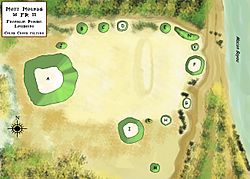Mott Archaeological Preserve facts for kids

Layout of the mounds at the Mott Site
|
|
| Location | Bonita, Louisiana, Franklin Parish, Louisiana, |
|---|---|
| Region | Franklin Parish, Louisiana |
| Coordinates | 32°18′33.19″N 91°30′20.30″W / 32.3092194°N 91.5056389°W |
| History | |
| Cultures | Marksville, Troyville, Coles Creek, Plaquemine |
| Site notes | |
| Excavation dates | 1900, 1913, 2005 |
| Archaeologists | George Beyer, Clarence Bloomfield Moore, Stephen Williams, Timothy Schilling, Tristram R. Kidder |
| Responsible body: private | |
The Mott Archaeological Preserve, also known as the Mott Mounds Site, is a very old place in Franklin Parish, Louisiana. It is located on the west bank of Bayou Macon. This site is special because it has many large mounds built by ancient people.
These mounds were created by different groups of people over a long time. These groups include the Marksville, Troyville, Coles Creek, and Plaquemine cultures. The Mott Mounds site was once one of the biggest mound centers in the southeastern United States. It even has one of the largest mounds in Louisiana, covering more than two acres at its base.
In 2002, the Archaeological Conservancy bought the site to protect it. Today, it is used for important research and for teaching people about ancient history.
Contents
What are the Mott Mounds?
The Mott Mounds site once had as many as fourteen mounds. Most of these mounds are built around a very large open space called a central plaza. This plaza is about 920 feet (280 meters) from east to west and 575 feet (175 meters) from north to south. To give you an idea, this plaza is about three-quarters the size of the Grand Plaza at Cahokia, which is the biggest known plaza built by ancient Mississippian people.
Many other large ancient sites from the same time period could fit entirely inside Mott's plaza. This shows how huge and important the Mott Mounds site was.
Mound A: The Biggest Mound
On the western side of the main plaza is Mound A. This is the largest mound at the site and one of the biggest in all of Louisiana. It is a platform mound, which means it has a flat top. It was likely used for important buildings or ceremonies.
Mound A is about 300 feet (90 meters) by 330 feet (100 meters) at its base. Its flat top is about 150 feet (45 meters) by 200 feet (60 meters). This huge mound stands over 26 feet (8 meters) tall. Its base covers more than two acres of land!
Other Mounds and Features
Two other large platform mounds, called Mound F and Mound I, are found on the eastern and southern edges of the plaza. On the northern side of the plaza, there are four smaller, dome-shaped mounds. These are lined up along an old bend in Bayou Macon.
About 2,300 feet (700 meters) south of the main mound group, there is a large village site. Experts believe this village was used by the same people who built and lived around the mounds.
How Do We Learn About Mott Mounds?
Archaeologists are like history detectives. They dig carefully into the ground to find clues about how people lived long ago. Many archaeologists have studied the Mott Mounds site.
Early Discoveries
The first known studies were done by George Beyer in 1900 and Clarence Bloomfield Moore in 1913. They helped us understand that this was an important ancient place.
Modern Research and Protection
In the mid-1960s, researchers from Harvard University, led by Stephen Williams, took samples from the site. They found signs from the Marksville, Coles Creek, and Plaquemine cultures. Their work showed that the site was most used during the Coles Creek period. More studies in 1976 and 1992 confirmed these findings.
The Mott Mounds site faced threats from people trying to steal artifacts, leveling the land, and cutting down trees. To protect this important historical place, the Archaeological Conservancy bought the site in 2002. It is now called the Mott Archaeological Preserve and covers over 200 acres. This makes it one of the largest sites the Conservancy has protected in the southeastern United States.
In 2005, a new project called the Mott Project began. It was led by Timothy Schilling from Washington University in St. Louis and Tristram R. Kidder from Tulane University. Their work continues to help us learn more about the ancient people who built and lived at Mott Mounds.


